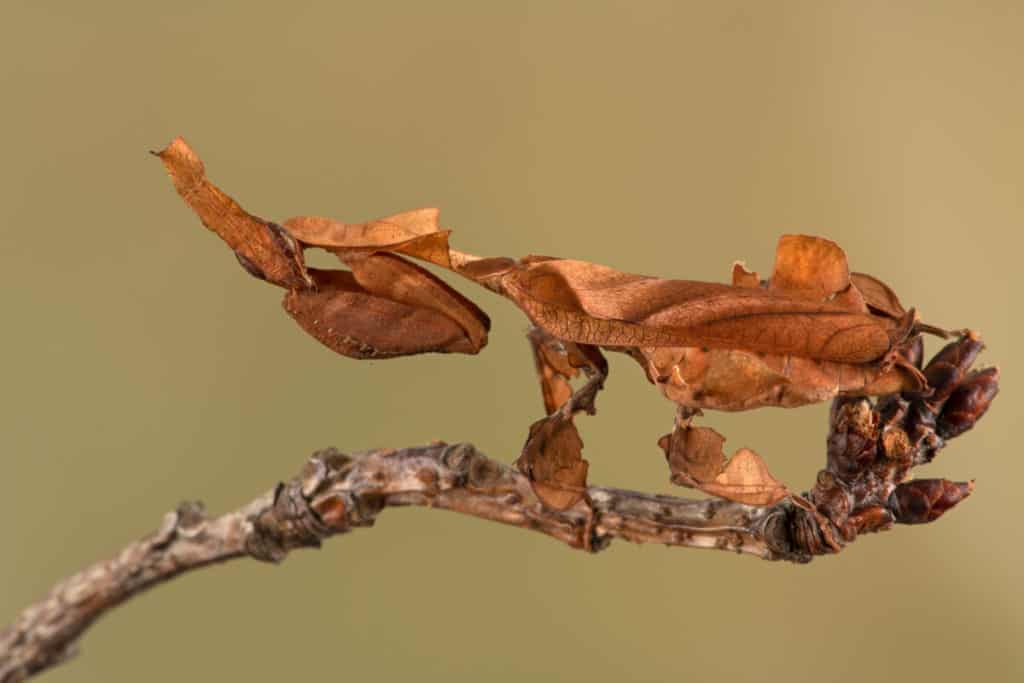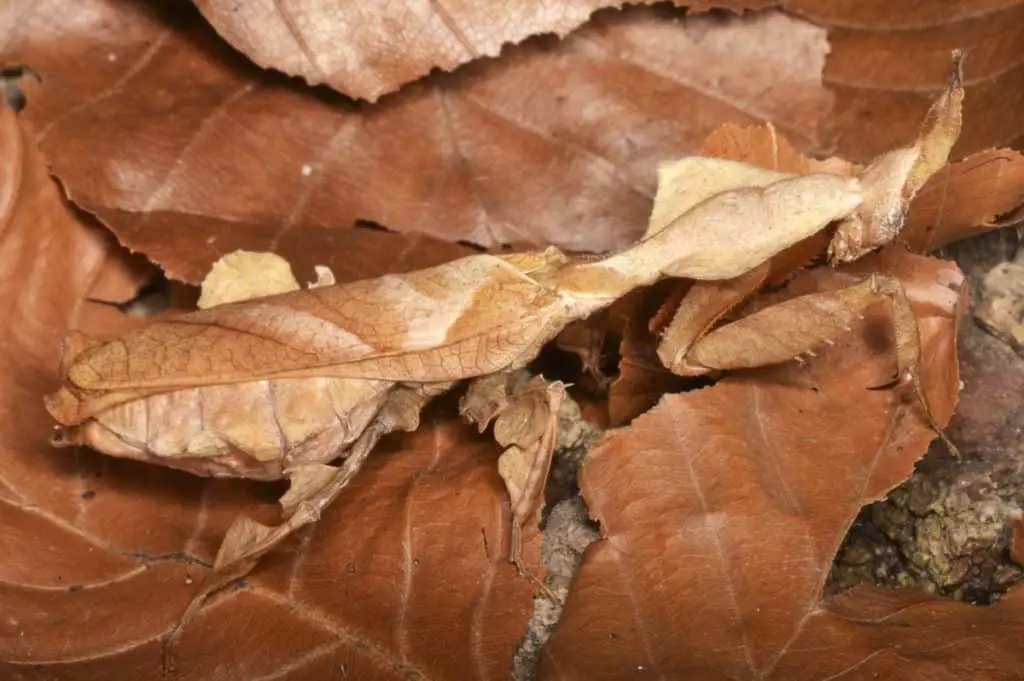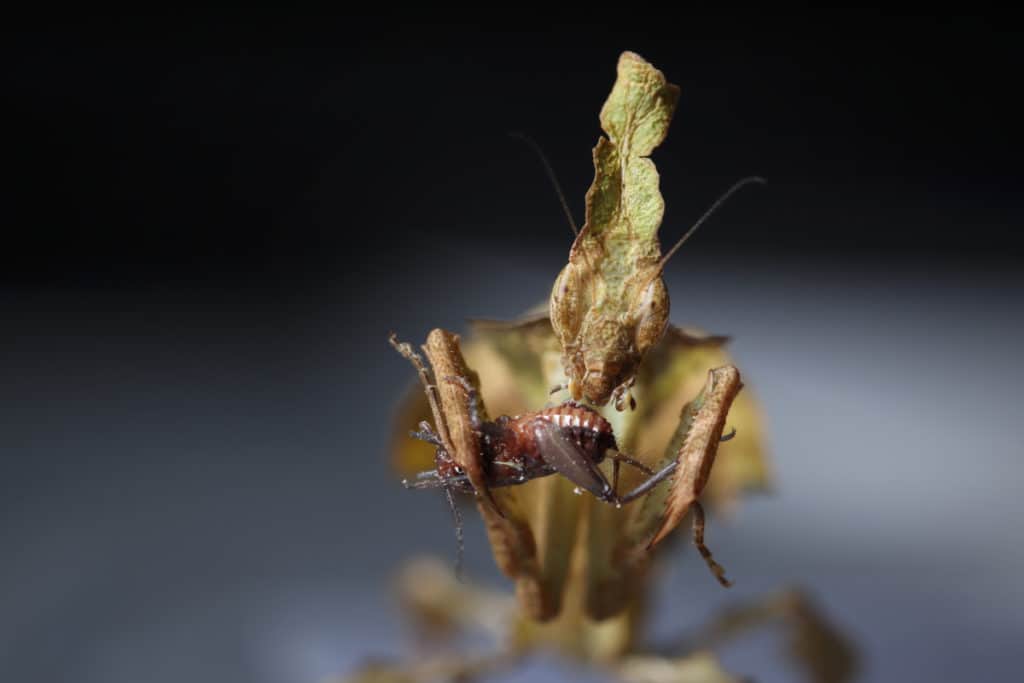Resembling a fallen leaf, the ghost mantis or Phyllocrania paradoxa is a Madagascan species, with a unique appearance and fascinating behavior. Just as every species belonging to the extensive praying mantis family, they’re voracious predators and effective hunters, by sneakily sitting among the leaves and waiting for the prey.
Having them as pets it’s like having a small version of the wild in your home. They stay motionless for hours and sometimes move like leaves dancing in the wind. You see their amazing hunting method, shedding their skins, and growing process.
Read on to discover everything you need to know about the ghost mantis, from its appearance and size to its habitat and mating. You’ll also learn about how you can keep a ghost mantis as a pet.
What Does A Ghost Mantis Look Like?
Ghost mantises belong to the praying mantises family, but compared to its cousins, it’s considered a “miniature species” growing to only about 45 to 50 millimeters (1.8 to 2.0 in) long. Like most insects, ghost mantises have six legs, two wings, and two antennae. The modified front legs help them catch and hold their prey.

The ghost mantis looks precisely like a dead leaf. So, the smart insect can camouflage effortlessly among the falling leaves waiting for its prey. The resemblance is so close that it’s almost impossible to tell a ghost mantis from actual leaves. The twisted leaf-shaped part on the head and broken leaf-like legs contribute to this similarity.
Adult female ghost mantises have a wider prothorax, six abdominal segments, and their wings are as long as the abdomen. The female’s crown is as broad as its head, smoother, and has more lines. On the other hand, you can recognize the male adults by their longer antennae, thinner bodies, and transparent wings, which are longer than their eight-segmented abdomen.
As they mature, they develop pronounced veins throughout their body parts, making them look even more like leaves.
Their appearance keeps them safe from predators such as insect-eating birds. At the same time, it makes it easier for them to hunt flies, crickets, and other small insects.
What Color Is The Ghost Mantis?
Ghost mantises are found in different colors, ranging from black and dark brown to light brown and green or greenish-gray. However, darker colors are more common.

Their coloration has nothing to do with genetics. It’s the environment that determines their colors based on the light, humidity, and of course, the color of their surroundings. For example, ghost mantises in more humid areas tend to be green.
If you are interested in the colors of praying mantis, then it would be worth checking another article we have written called, Do Praying Mantis Change Color?
Where Do Ghost Mantises Live?
Being native to the lush forests of Madagascar, Africa, you can find the leaf resembling insects in trees, bushes, shrubs, and on open land, usually hanging upside down from tree branches. They live in areas with a moderate temperature between 20º C to 30º C and can’t tolerate temperatures below 18º C for long. The perfect temperature is about 26º C because they prefer warm places with relatively high humidity, 60 to 90 percent.
What Does A Ghost Mantis Eat?
Ghost mantises mainly eat flying insects like flies and crickets, but sometimes they hunt slow-moving cockroaches as well. They only eat live prey and prefer highly active insects.

They’re called a sit-and-wait predator, meaning they camouflage until the food comes along, and then they attack very fast. Before the target realizes it, it’s stuck between the claws of this predator and only catches its prey if it’s moving in their grabbing distance.
Interestingly, the ghost mantis, especially an adult male, can easily get intimidated by its prey’s size and even run away instead of attacking it.
We do have an entire article on the diets and hunting habits of praying mantis if you are interested. The article is called, What Do Praying Mantis Eat? (With Video Hunting A Fish)
The Ghost Mantis Life Cycle
Life Stages
Ghost mantises are hemimetabolous insects, which means they don’t undergo a complete metamorphosis like a butterfly or beetle. Butterflies, as an example, go through the larva stage, pupa, and adult. They look entirely different in each stage of their life in a way that an adult has nothing like the larva. On the other hand, a newborn praying mantis looks like its adult parents except for the size, color, and wings.
Before reaching adulthood, a mantis nymph sheds its skin about six to nine times, depending on the species and sex. The mantis will grow every time it sheds. It can’t grow in between molts because of its hard skin.
Scientists use a number to designate every stage of a mantis’ life. A newborn mantis is L1 and becomes an L2 after its first shedding. The number is incremented until the nymph becomes an adult.
The females live between 8 to 12 months, depending on their living conditions. They molt approximately seven times before adulthood (which is L8). The males have shorter lifespans. On average, a male ghost mantis lives for 7.5 months: two months as an adult and 5.5 months before that. It passes six molts to turn into an adult (L7)
Mating Time
Ghost mantises are ready for mating about two weeks after their final molt. When the time comes, the male sits on top of the female without copulating. It takes several hours to make a move, and that’s why mating can last several days.
Within several weeks, the female sticks some clutches of eggs to branches or sidewalls. The eggs need the same conditions as the adults, warm and humid.
Laying Eggs
The female mantis lays eggs in the form of an ootheca, a cluster of eggs stuck together by foam. The foam immediately hardens to protect the eggs from predators, cold weather, and drying up.
The average number of eggs in an ootheca is 10 to 40 eggs, but it can contain up to 50. To stick their ootheca, females release a foamy liquid containing protein by spiral-shaped abdomen movements. The egg case becomes rigid and forms a firm sponge-like cocoon.
The nymphs need approximately four weeks before they’re ready to hatch through the thin wall around them. The ideal hatching temperature is 29º C.
For more information about praying mantis eggs, we have written another article called, Do Praying Mantis Die After Laying Eggs?
How To Keep Ghost Mantises as Pets
It’s fun to have a mantis pet, and it’s not difficult at all. However, like all animals, there are some basic rules to consider if you want a healthy pet.
Housing
To keep a ghost mantis in an enclosed space, you need a box, cage, or terrarium with the right dimensions. It should be at least three times the animal’s length in height and at least twice its length in width. This measurement means at least 15 cm in height and 10 cm in width so that the mantis has enough space to walk around and shed its skin.
Put something that absorbs water and doesn’t mold easily on the bottom of the box. It could be tissue paper, shredded wood, or sand. Vermiculite or potting earth can also do the trick. The goal of this flooring is to release water slowly and keep constant humidity in the box.
Add some branches, plants, reeds, or sticks to the box where your mantis can sit or hang from. Fake plastic ones are okay too, but make sure they don’t contain any glue or insecticides. Also, make sure the box doesn’t get too cramped once you add the plants.
The container must have a top to let the mantis hang upside down when molting and prevent it from escaping. Several ventilation holes are also necessary so that it has enough air to breathe easily and the extra moisture drys up. A mesh door can provide sufficient ventilation.
Room temperature is acceptable in the summer, but you need a heating mat during winter.
To clean the container, empty it, remove any half-eaten food, and wash it with hot water. Don’t use any detergents because they harm the mantis. Dry the box and put new substrate.
Watering
Ghost mantises don’t drink water from a container like other pets- they use the droplets on the plants. You need to spray water to cause a light mist for your mantis to simulate similar conditions. However, they don’t like to be sprayed directly, so you should spray around them. If the container has a mesh door, you can spray water on it, and it’ll be like raindrops.
It’s better not to use regular tap water, instead, use spring water, distilled water, or reverse osmosis (RO) filtered water. When the mantis is young, spraying five to seven times a week is suitable, but you should reduce it to three times a week for adults.
Feeding
To feed your mantis, give it flies, although they don’t say no to small grasshoppers and crickets. Remember that they only eat live insects, and they can catch prey more easily if it moves a lot. That’s why a fly is better than insects that might hide, such as cockroaches.
The food should be the same size as their head because a large prey can frighten them. Plus, their arms aren’t strong enough to hold a giant insect, and it’s difficult for them to eat it.
Large tweezers or the owner’s hand can scare the mantis too and make it refuse the prey. If this happens during feeding, just wait fifteen minutes and try again. When you feed them, watch them and make sure they eat the food, or else they might not find it and starve.
The younger ones eat a lot. The males tend to become less voracious as they mature, but the adult female eats a lot every day.
Mating
To make your ghost mantises mate and reproduce, just put a male and a female in the same place two weeks after their last molt. If they’re in groups, there’s nothing to do, and they’ll reproduce as usual. Remember to feed the females very well as expected because they eat more than males.
Frequently Asked Questions About Ghost Mantises
How Does A Ghost Mantis See the World?
Praying mantises have a much better sight compared to other insects because of their stereo-vision. This kind of vision means they can look at a spot with two eyes and recognize the distance accurately. They have other senses such as hearing, feeling, taste, and smell, but they mostly rely on their sight.
Are Ghost Mantises Dangerous For Humans?
While their spooky name, bizarre appearance, and bad rep may seem a terrifying combination for some, ghost mantises do not pose any danger to humans.
Don’t be fooled though, they will most definitely bite you if you approached aggressively. The bite, however, does minor damage, and it’s not lasting as they don’t have any venom.
For more about the bite of praying mantis check out his article we have written, Do Praying Mantis Bite?
Do Ghost Mantises Eat Each Other?
Unlike most mantis species, ghost mantises aren’t aggressive and can live together without cannibalism. However, they need plenty of space and food, such as flies to prey, because even these quiet species will turn on each other if they run out of food.
They also need to be of the same age and size. So, there’s still a small risk of cannibalism.
The Wrap Up
The ghost mantis is a leaf-like praying mantis from Madagascar. It can camouflage effortlessly among dry leaves because of its look. It prefers warm areas around 26ºC with a high relative humidity level. This sit-and-wait predator eats flying insects or other small insects that move around.
They live about 7 to 12 months and shed their skin about 6 or 7 times before entering adulthood. After mating, the females reproduce by laying 10 to 40 eggs in a cluster. When they hatch, the newborns look like adults with slight differences.
The ghost mantis can be a great pet and requires minimal care to stay healthy and strong.
Interested in knowing more about other species of praying mantis or maybe you are looking at keeping a praying mantis as a pet? Then you might be interested in these other articles we have written:
Are White Praying Mantises Rare?
The Giant Asian Mantis: Your Complete Guide
The Devil’s Flower Mantis: Your Complete Guide
The Budwing Mantis: Your Complete Guide
The Spiny Flower Mantis: Your Complete Guide
Sources
https://www.antskingdom.com/ghost-mantis-phyllocrania-paradoxa.html
https://www.panterrapets.com/pages/ghost-mantis-caresheet
https://www.exotic-pets.co.uk/ghost-mantis.html
https://www.pbspettravel.co.uk/blog/keeping-praying-mantis-as-pets-the-beginners-guide/
